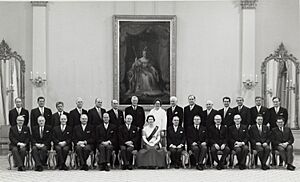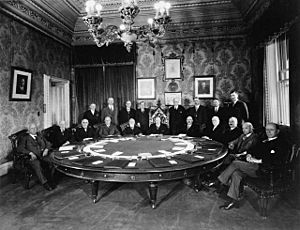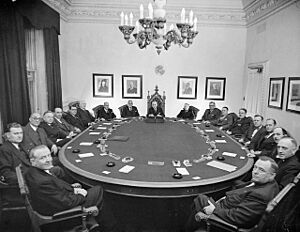Cabinet of Canada facts for kids
The Canadian Ministry (also called the Cabinet of Canada) is a special group of important people who help run the government of Canada. Think of them as the main team of advisors to the Prime Minister. They work with the King of Canada to make big decisions for the country. The Prime Minister is the leader of this team.
The words "Cabinet" and "Ministry" are often used to mean the same thing, but they are slightly different. The Cabinet is a smaller, more active group within the larger Ministry. As of 2025, almost everyone in the Ministry is also part of the Cabinet. The current Cabinet is led by Mark Carney and is part of the 30th Ministry.
Contents
What is the Canadian Cabinet?
How the Government Works
Canada's government is officially called "His Majesty's Government". This means the King makes decisions based on advice from his Privy Council. This is sometimes called the "Governor-in-Council" because the Governor General acts on behalf of the King in Canada.
The full Privy Council is a large group, but it rarely meets. Instead, a smaller group called the Cabinet gives advice every day. These Cabinet members are usually elected members of Parliament. This system is called responsible government, which means the people giving advice must be accountable to the elected House of Commons.

The King or Governor General usually follows the advice of the Cabinet. However, in very rare and serious situations, the King or Governor General can use their own powers to protect Parliament or the people. For example, they could stop a Prime Minister from calling too many elections.
One of the main jobs of the King's representative (the Governor General) is to choose the Prime Minister. This is usually the leader of the political party that has the most seats in the House of Commons. If no party has a clear majority, the Governor General must decide who is most likely to lead the country well. The Prime Minister then chooses the rest of the Cabinet. The King is always kept informed about these important changes.
Choosing Cabinet Members
The Governor General officially appoints people to the Cabinet, but they are chosen by the Prime Minister. There are no strict laws about who can be a minister, but there are some traditions:
- Usually, there is a minister from each province.
- Efforts are made to include ministers from diverse backgrounds, people with disabilities, Indigenous groups, and women.
- Most ministers are Members of Parliament (MPs), but sometimes a senator is chosen, especially to represent a province where the ruling party has few MPs.

The size of the Canadian Cabinet can change. In the past, Cabinets grew quite large, but they have been made smaller at different times. For example, in 1994, there were 23 people in the Cabinet. More recently, the Cabinet has had around 37 to 39 ministers.
The Cabinet also has smaller groups called committees. One very important committee is the Treasury Board, which looks after how the government spends money. Other committees focus on things like economic growth, foreign affairs, the environment, and social issues. Each committee is led by a senior minister.
Ministers and Their Roles
Each minister in the Cabinet is in charge of at least one government area, like health or finance. These areas are called "portfolios," and they have their own government departments.
- The Minister of Finance is usually the most important minister after the Prime Minister.
- Other key roles include Foreign Affairs, Industry, Justice, and Health.
Some ministers have unique roles without a specific department, like the Leader of the Government in the House of Commons. Sometimes, a Prime Minister might appoint a "minister without portfolio" who has no specific department but helps with special tasks.
Unlike some other countries, ministers of state in Canada are considered full members of the Cabinet. They are given specific, often temporary, tasks within a larger department or for special projects.
Ministers get help from parliamentary secretaries, who answer questions in the House of Commons, and deputy ministers, who are senior public servants giving expert advice.
What Does the Cabinet Do?
The Cabinet has a lot of power in Canada. Since the ruling party usually has the most seats in Parliament, most new laws suggested by the Cabinet are approved. This means the Cabinet has a lot of control over what laws are made. Also, any new law that involves raising or spending public money must start with the Cabinet.
The Cabinet also appoints many important officials, like the heads of Crown corporations (government-owned businesses). They can also call for royal commissions or public investigations into important issues.
Cabinet meetings are private, and what is discussed is kept secret for 30 years. Once a decision is made, all Cabinet members must support it publicly, even if they disagreed privately. If a minister breaks these rules, they might be removed by the Prime Minister. Sometimes, a minister might resign if they strongly disagree with a Cabinet decision, like John Turner did in 1975 over wage controls.
Some experts believe that the Prime Minister's power has grown so much that the Cabinet sometimes acts more like a "sounding board" for the Prime Minister's ideas rather than a group that makes decisions together.
Shadow Cabinets
Each opposition party in Canada has a "shadow cabinet". These are groups of members from the opposition party who watch over and comment on the work of the actual Cabinet ministers. They suggest different ideas and policies. The main opposition party's shadow cabinet is often seen as a "government in waiting," meaning its members might become actual ministers if their party wins the next election.
Current Cabinet
| Cabinet ministers | ||||||||||
|---|---|---|---|---|---|---|---|---|---|---|
30th Canadian Ministry (Listed according to the Canadian order of precedence) |
||||||||||
| Ministry | Date of creation | Incumbent | Province | Minister since | Precedence date | |||||
| Prime Minister of Canada | July 1, 1867 | Mark Carney | QC | March 14, 2025 | March 14, 2025 | |||||
| Deputy Prime Minister of Canada | September 16, 1977 | Vacant | N/A | December 16, 2024 | N/A | |||||
| Minister of International Trade and Intergovernmental Affairs | July 1, 1867 | Dominic LeBlanc | NB | December 20, 2024 | July 20, 2004 | |||||
| President of the King's Privy Council for Canada | October 26, 2021 | March 14, 2025 | ||||||||
| Minister of Foreign Affairs and International Development | November 4, 1993 | Mélanie Joly | QC | October 26, 2021 | November 4, 2015 | |||||
| Minister of Finance | July 1, 1867 | François-Philippe Champagne | QC | March 14, 2025 | January 10, 2017 | |||||
| Minister of Innovation, Science, and Industry | March 29, 1995 | Anita Anand | ON | March 14, 2025 | November 20, 2019 | |||||
| Minister of National Defence | January 1, 1923 | Bill Blair | ON | July 26, 2023 | July 18, 2018 | |||||
| Minister of Indigenous Services | August 28, 2017 | Patty Hajdu | ON | October 26, 2021 | November 4, 2015 | |||||
| Minister of Energy and Natural Resources | January 12, 1995 | Jonathan Wilkinson | BC | July 26, 2023 | July 18, 2018 | |||||
| President of the Treasury Board | October 1, 1966 | Ginette Petitpas Taylor | NB | December 20, 2024 | August 28, 2017 | |||||
| Minister of Canadian Culture and Identity, Parks Canada | July 12, 1996 | Steven Guilbeault | QC | March 14, 2025 | November 20, 2019 | |||||
| Minister of Transport and Internal Trade | November 2, 1936 | Chrystia Freeland | ON | March 14, 2025 | November 4, 2015 | |||||
| Minister of Health | October 26, 2021 | Kamal Khera | ON | March 14, 2025 | October 26, 2021 | |||||
| Minister of Crown–Indigenous Relations | August 28, 2017 | Gary Anandasangaree | ON | July 26, 2023 | July 26, 2023 | |||||
| Minister of Justice and Attorney General of Canada | March 14, 2025 | March 14, 2025 | ||||||||
| Chief Government Whip | Rechie Valdez | ON | March 14, 2025 | July 26, 2023 | ||||||
| Minister of Jobs and Families | March 14, 2025 | Steven MacKinnon | QC | March 14, 2025 | August 28, 2017 | |||||
| Minister of Fisheries, Oceans and the Canadian Coast Guard | April 2, 1979 | Diane Lebouthillier | QC | July 26, 2023 | ||||||
| President of the King's Privy Council for Canada | July 1, 1867 | Harjit Sajjan | BC | July 26, 2023 | ||||||
| Minister of Emergency Preparedness | October 26, 2021 | July 26, 2023 | ||||||||
| Minister responsible for the Pacific Economic Development Agency of Canada | October 26, 2021 | October 26, 2021 | ||||||||
| Minister of International Development | 25 January 1996 | Ahmed Hussen | ON | July 26, 2023 | ||||||
| Minister of Export Promotion, International Trade and Economic Development | October 26, 2021 | Mary Ng | ON | July 26, 2023 | ||||||
| Minister of Immigration, Refugees and Citizenship | June 30, 1994 | Marc Miller | QC | July 26, 2023 | ||||||
| Minister of Health | July 12, 1996 | Mark Holland | ON | July 26, 2023 | September 14, 2018 | |||||
| Minister responsible for the Atlantic Canada Opportunities Agency | September 15, 1988 | Gudie Hutchings | NL | July 26, 2023 | October 26, 2021 | |||||
| Minister of Rural Economic Development | January 14, 2019 | October 26, 2021 | ||||||||
| Minister for Women and Gender Equality and Youth | June 11, 1971 | Marci Ien | ON | October 26, 2021 | ||||||
| Minister of Canadian Heritage | July 12, 1996 | Pascale St-Onge | QC | July 26, 2023 | ||||||
| Minister of Tourism | June 25, 1993 | February 6, 2025 | ||||||||
| Minister responsible for the Economic Development Agency of Canada for the Regions of Quebec | June 25, 1993 | |||||||||
| Minister of Citizens' Services | July 26, 2023 | Terry Beech | BC | July 26, 2023 | ||||||
| Minister of Mental Health and Addictions | October 26, 2021 | Ya'ara Saks | ON | |||||||
| Associate Minister of Health | October 26, 2021 | |||||||||
| Minister of Families, Children, and Social Development | December 12, 2003 | Jenna Sudds | ON | |||||||
| Minister of Justice and Attorney General | July 1, 1867 | Arif Virani | ON | |||||||
| Minister of Public Safety | December 12, 2003 | David McGuinty | ON | December 20, 2024 | January 8, 2018 | |||||
| Minister of Democratic Institutions | December 12, 2003 | Ruby Sahota | ON | January 19, 2024 | ||||||
| Minister responsible for the Federal Economic Development Agency for Southern Ontario | October 26, 2021 | |||||||||
| Minister of Official Languages | December 12, 2003 | Rachel Bendayan | QC | December 20, 2024 | ||||||
| Associate Minister of Public Safety | December 20, 2024 | |||||||||
| Minister of National Revenue | March 21, 1927 | Élisabeth Brière | QC | |||||||
| Minister of Sport | December 12, 2003 | Terry Duguid | MB | |||||||
| Minister responsible for Prairies Economic Development Canada | October 26, 2021 | |||||||||
| Minister of Housing, Infrastructure and Communities | November 4, 2015 | Nathaniel Erskine-Smith | ON | |||||||
| Minister of Veterans Affairs | December 12, 2003 | Darren Fisher | NS | |||||||
| Associate Minister of National Defence | July 12, 1940 | |||||||||
| Minister of Seniors | January 4, 2011 | Joanne Thompson | NL | |||||||
Images for kids
-
The 16th Canadian Ministry, led by William Lyon Mackenzie King, in 1945.
See also
 In Spanish: Gabinete de Canadá para niños
In Spanish: Gabinete de Canadá para niños
- List of Canadian ministries
- Structure of the Canadian federal government



